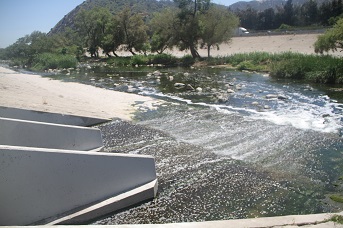Special journal issue highlights statewide stream flow management framework

A new scientific framework intended to bring standardization and technical rigor to the process of determining environmental flow needs for California streams is prominently featured in a special issue of a peer-reviewed journal – a key milestone in ongoing efforts by SCCWRP and its partners to promote more widespread management adoption of the framework.
The special issue of Frontiers in Environmental Science – made up of 20 open-access articles being published in phases through this summer – includes seven journal articles that describe the California Environmental Flows Framework (CEFF), a methodical, multi-step process for determining the magnitude, duration and frequency of stream flows needed to protect ecological integrity, recreational opportunities and other beneficial uses.
The CEFF-focused articles include an overview of the CEFF development process, as well as the findings of two SCCWRP-facilitated Southern California case studies that used the framework to build a technical foundation for updating flow management practices in the Los Angeles River and southern Orange County streams, respectively.
The special journal issue, titled “Environmental Flows in an Uncertain Future” and co-edited by SCCWRP, represents the successful culmination of the scientific peer review process for CEFF.
The development of the framework follows more than a decade of scientific research, deliberation and debate about how to appropriately update flow management practices across drought-prone California.
Historically, the scientific basis for flow management has consisted of non-standardized analyses aimed at protecting the hydrologic flow needs of a single species or a single beneficial use. Managers also have tended to focus on restoring flow patterns to their natural historical state, without necessarily considering if or how these natural flows translate into improved ecosystem functioning.
CEFF takes advances of recent advances in flow-ecology science to comprehensively redesign California’s approach to flow management. Instead of focusing narrowly on a single species or a single beneficial use, CEFF calls on managers to consider the flows needed to support stream ecosystems and processes, in addition to multiple beneficial uses. The framework also refocuses managers’ attention on protecting specific, ecologically important “functional” attributes of a stream’s flow patterns over the course of a year – as opposed to focusing on flow patterns during a specific time of the year or a single species at a specific life stage, or trying to automatically restore flows to natural, historical conditions.
In addition to journal peer review, the California Environmental Flows Framework also has undergone multiple rounds of technical and stakeholder review.
The State Water Board is planning to use the framework as the basis for deciding whether to approve a pair of Los Angeles River diversion proposals submitted last year by two City of Los Angeles divisions – the Bureau of Sanitation and the Department of Water and Power. The agencies are seeking to recycle more wastewater effluent and stormwater discharges, respectively, instead of releasing their discharges into the L.A. River.
Meanwhile, the State Water Board’s Division of Water Rights intends to use the framework as the basis for deciding how to award water rights to cannabis growers, which are requesting to divert water from California streams to support cannabis cultivation.
The 14 non-CEFF-related articles in the special issue of Frontiers in Environmental Science chronicle advances in environmental flow management in other parts of the world, including the U.K. and Australia.
Significantly, all of these advances, including CEFF, share a common scientific foundation: They are all based on a holistic scientific approach to flow management known as the Ecological Limits of Hydrologic Alteration (ELOHA) that was developed by the U.S. Environmental Protection Agency in 2010.
Once all 20 articles have been published, the journal will package all of the articles together as an e-book; all seven CEFF-focused articles already have been published and can be read for free online.
For more information, contact Dr. Kris Taniguchi-Quan.
More news related to: Ecohydrology, Top News